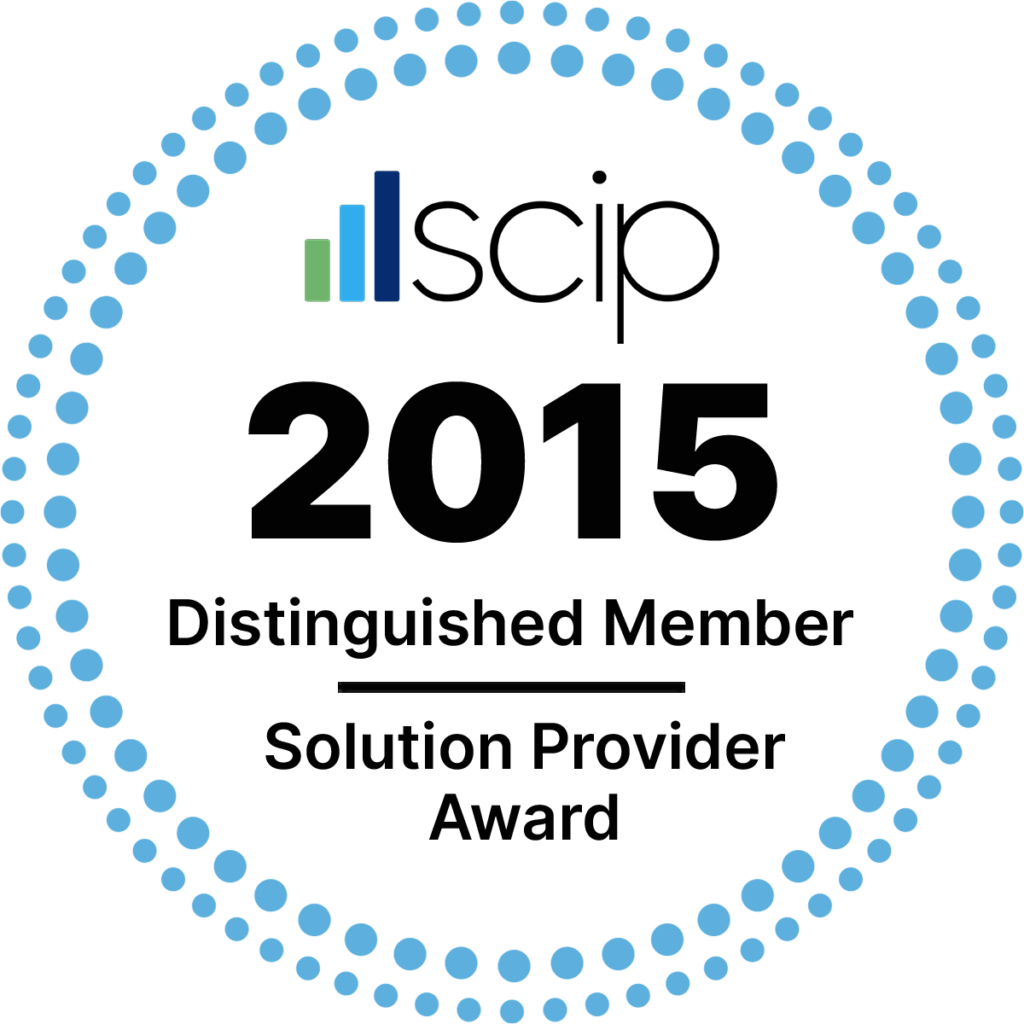Published: January 7, 2020

Data is information, pure and simple. What your organization does with that information, though, is not so straightforward — yet has the potential to shape its operational, financial and strategic livelihood.
Take your organization from a passive data-tracker to an active, nimble and competitive player by shaping a culture of actionable intelligence. By doing so, you increase your ability to spot risks and opportunities before they strike, then create fluid business strategies directly addressing those opportunities before it’s too late.
How Is Actionable Data Different?
Actionable data is the difference between organizations operating under a truly empowered business performance management ecosystem and those stuck on the hamster wheel of data aggregation.
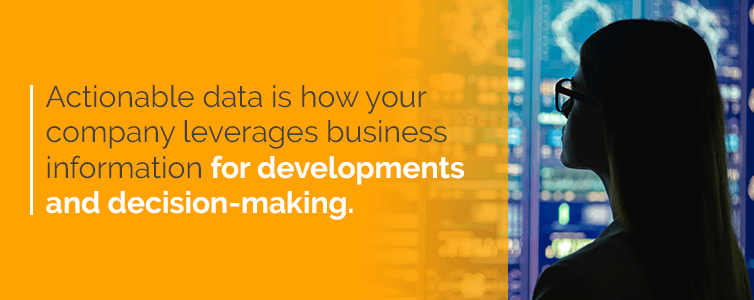
In other words, its how your company leverages business information for developments and decision-making — something over half of all executives admits to struggling with:
- Only 31% claim their company is “data-driven.”
- More than 50% don’t see their organization treating data as a business asset.
- Nearly three-fourths (72%) report their company doesn’t even have a set data culture, which includes tools, systems and workflows to translate data into real-life business-process ideas.
This last figure — 72% of companies missing a data culture — is particularly concerning. Without actionable data strategies, businesses have no blueprint on how to make sales, finance, customer support, product, service or market changes for efficiency, cost-reductions and growth. The results are business strategies forged in the dark — if done at all.
In comparison, 31% of organizations that do have data-driven strategic intelligence are more like to have a business that runs as follows:
- Unsiloed data access: Business leaders and their teams have immediate access to a wealth of market intelligence and business intelligence data, typically through analytic software generating reports.
- Functional, user-friendly filters: Business leaders and their teams can filter those large amounts of data to find what they’re looking for quickly, even amidst consolidated data warehouses or data lakes.
- Real-time analysis: Business leaders and their teams can create new KPIs or benchmarks for a specific function based on the latest and most accurate data rather than historical reports.
- Swift, decisive action: Up-to-date data sets and updates reduce decision-making latency, empowering almost real-time tweaks or operational changes right when the opportunity strikes, plus mitigates losses or boosts risk management as soon as data tools alert you to them.
Why Real-Time, Actionable CI Is Important
Building a culture around actionable intelligence has never been more important — for these reasons and more.
1. Exchange Rates Fluctuate Daily
Depreciation and appreciation trigger downstream effects across business operations. Changes in the value of a currency will create more competitive markets to enter for yourself and your competitors alike. Tracking these fluctuations allows savvy organizations to recognize currency and market fads from true, profitable opportunities, as well as navigate more cost-effective contracts in raw material procurement, shipping channels, inflation, demand elasticity and more.
Don’t make the assumption only imports and exports are affected by near-daily exchange rate fluctuations. Your own purchasing power — plus the power of your customers’ and clients’ money — will also adapt, spelling potential profit disruptions in key marketplaces.

2. Geographic Sales Patterns Evolve
Up-to-date, accurate market intelligence data provides companies with a more complete blueprint for sales and demand forecasting in key geographic regions. Rather than rely on historical data sets, such as past sales by SKU or per capita sales, or playing a game of broad sales guesswork, your organization can strategically re-order inventory, properly stock warehouses, determine last-mile logistics and improve overall customer satisfaction.
Actionable data also provides elevated insights into other sales metrics, such as:
- Category development index (CDI) by country, region, state or city
- Brand development index (BDI) by country, region, state or city
- Competitive market share compared to top competitors in distinct regions
- And more
3. Transportation Logistics and Delivery Schedules Change
Quicker and more transparent data alerts leadership to dysfunctional or inefficient transportation logistics. Organizations today struggle to stay atop rapidly-changing transportation and delivery norms, many of which catalyzed in response to the explosion of online shopping and the proverbial Amazon Effect changing the logistics supply chain.
For businesses from retail consumer goods brands to manufacturers, competitive intelligence bolsters smarter end-to-end transportation logistics, including:
- Improved carrier management
- Improved fleet fueling
- New freight forwarding and shipment consolidation opportunities
- Reduced inventory holding costs
- And more

4. Consumer Tastes Adapt
Data-guided intelligence lets you become as familiar with your customers as possible. This actionable data delivers thorough, objective purchasing and demographic information that peers behind the consumer lifestyle and preferences curtains, as well as informs consumer-taste patterns and habits among target demographics for your organization to capitalize on.
Getting inside current and target demographics’ heads allows you to preempt relevant trends, incorporating them into your products, services and brand far ahead of the competition, all while evolving into a brand widely regarded by the public as “ahead of its time.”
5. Colleagues Need Accurate Information
Just as enterprise and department priorities shift, so do individuals’ workloads. Fellow employees are hindered in their roles if they cannot quickly access the latest enterprise reports, muddling their abilities to execute core assignments. Their outputs suffer, as do the related functions of the departments they work in.
In simpler terms, having accessible, actionable data in place ensures everyone can do their jobs to the best of their abilities. Implementing a data-informed process of competitive intelligence empowers further role innovation and job excellence, propelling savvier decision-making, efficiency and project excellence in every position.
How Do You Find Meaning in Data?
Today, organizations are ever-pressed to gather swaths of data using suites of operational and analytic tools tracking every major business function under the sun, from sales, finance and procurement to pricing, customer satisfaction, brand awareness and more.
Once gathered, what do you do with that data? Your answer likely determines your strategic intelligence maturity level — that is, how advanced your organization is at institutionalizing workflows that interpret quantitative information into actual business process tweaks.
To mature along the strategic intelligence matrix — and get the most from data — organizations must pass through the following stages.
1. Synthesize Disparate Data Sources
Central data repositories streamline the often separate, department-specific data tools deployed across the enterprise. For example, a single company may support multiple disparate programs, such as:
- Operational databases, such as warehouse management software
- Relational databases, such as database maintenance and security programs
- Business databases and applications, such as enterprise resource planning and project management software
Strategic intelligence starts on the right foot when these disparate systems are integrated and accessible under one umbrella data warehouse or a similar online analytical processing system. These total-aggregation programs unlock your ability to perform ad-hoc data mining requests and reports, the key first step to using data for actionable competitive intelligence.
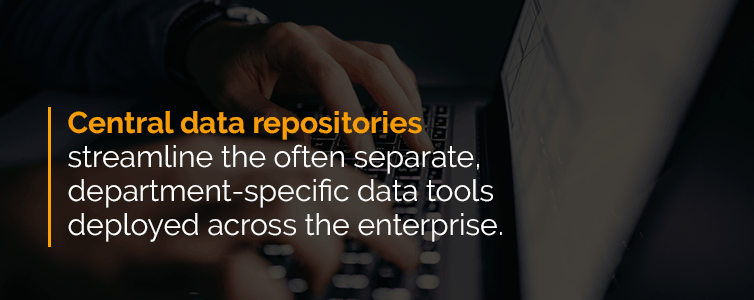
2. Add Context
Reports generated by your synthesized data warehouse are just that — raw reports. Creating reports is not to be confused with performing data analytics or conducting competitive intelligence itself. Instead, use reports as the bedrock for ideating the reasons behind data patterns or fluctuations. Data mine further to observe additional patterns or peculiarities, connecting the dots between information systems that were previously siloed. Look beyond raw data as well for additional market situations and environments that could be affecting your current situation. All this context allows business leaders to see the greater forces at play directing potential risks or calls for change.
3. Translate Data Into Specific Business Questions
Frame data in grounded, concrete questions using terms actually relevant to the average layperson, not just expert data analysts. For example, reports should be reviewed while keeping the following in mind:
- What are we trying to achieve by reviewing this report?
- Will tweaking a certain business process lead to improvements that would otherwise remain unachievable?
- What roles or departments is this information most critical for?
- Can we run projective data tests or mock scenarios before committing to an action plan?
- How will we measure the success of our business process change? What data metrics or KPIs can we create for follow-up?
4. Determine the Best Course of Action
Using your freshly-built business case, you’re prepared to identify a data-shaped yet coherent course of action to remedy the pressing business need or pain point.
That business planning action course isn’t a shot in the dark. It comes based on objective information first triggered by a pattern or figure spotted in your reports, but is boosted by context and comes with designated KPIs to track future success. By using concrete data, your organization no longer plays guesswork when it comes to executing critical decisions.

5. Communicate That Action to All
The chosen course of action may also include a presentation layer, or how you intend to follow-up on the success or future needs of your course of action.
Use visual tools to communicate the new business process change and how it will affect relevant operations, KPIs to track its progress as well as access to the original reports that first triggered analysis. Keeping all relevant personnel in the loop ensures employees and teams across the enterprise work from a single point of truth, plus understand the justifications for the change.
Tips for Implementing Actionable Intelligence
Uncover deeper insights from your competitive intelligence data with these best practices.
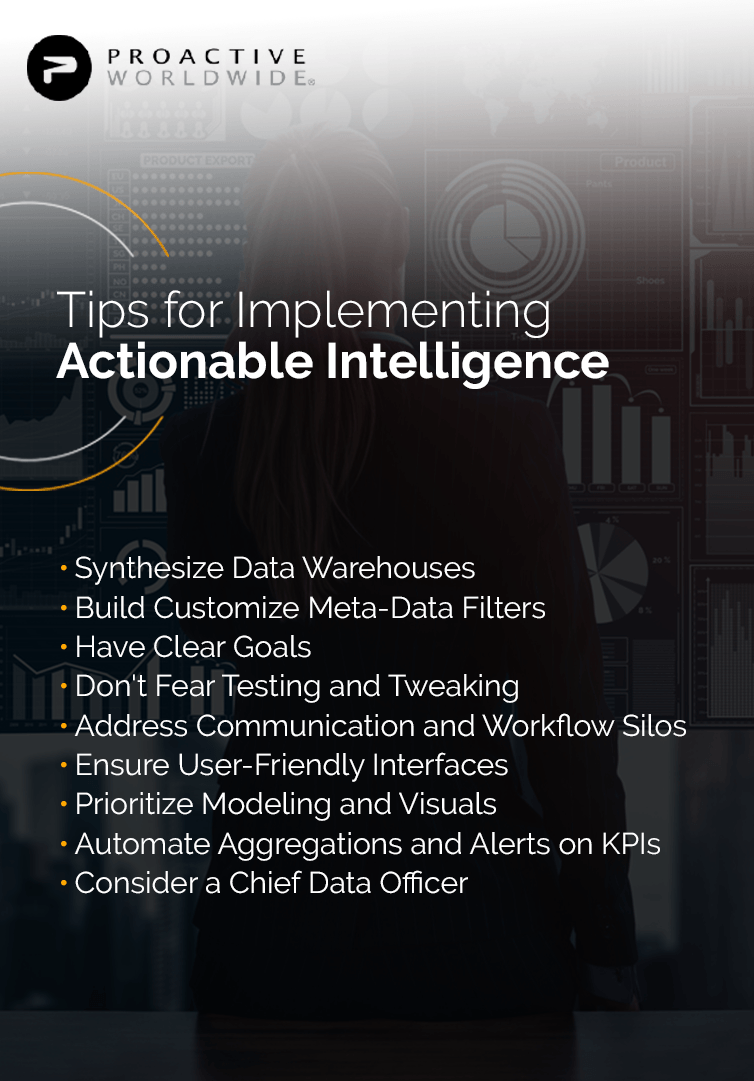
1. Synthesize Data Warehouses
An enterprise-wide, meta-data source begets faster and smoother business decisions. From one system, users have access to:
- CRM platform data
- Sales software data
- ERP software data
- Warehouse and inventory management data
- And more
Managing one central competitive intelligence repository like this gives all users, regardless of department or data-analytics skill sets, access to uniform values and data sources. Harmoniously synced data can be difficult to generate across separate programs, which may label, arrange and field data sets differently and may even require standardization rules to initiate cohesive tracking. With a large data solution, you bypass that standardization and reduce data redundancies and manual inputting errors.
2. Build Customize Meta-Data Filters
Customized filters make it easy to access and reference specific business unit data you need, right when you need it. It’s a user-friendly database feature leading to many advantages:
- Quicker buy-in for new competitive-intelligence data repositories, with employees and teams able to locate the information they need easily.
- Faster understanding of business-critical information, with data arranged according to relevant business units.
- Easier cross-employee and team data sharing, without the need to re-standardize or reclassify data.
3. Have Clear Goals
Too many organizations fall victim to tracking everything, all at once. This results in big-data saturation, with so many metrics and performance indicators for decision-makers to review that the act of data analysis itself becomes overwhelming — and shapeless.
Remember, actionable data is also approachable data. Simplify your analysis activities and ideate more pinpointed business process changes by entering analysis sessions with clear questions to answer or project parameters in mind. Field concerns from others on your team and department as well before accessing reports. They, too, may have questions or specific needs data can clarify. Use these inquiries as the map guiding your time with reports, rather than diving into them as a general to-do without any purpose or focus.
4. Don’t Fear Testing and Tweaking
Running market intelligence simulations is one of the best ways to prepare your team for future business scenarios. With an actionable data culture in place, these simulations are easier to conduct step-by-step:
- Define a specific business pain point or department question.
- Field reports to query only data relevant to those pain points or questions, but pulling from multiple business functions’ applications.
- Search for anomalies, patterns, changes or disruptions that may indicate a greater force is at play.
- Create a direct action plan addressing that larger force.
- Run data simulations with targeted KPIs to forecast how your action plan may play out.
- Improve the action plan based on forecasts.
- Continue to track action plan KPIs as they unfold.
5. Address Communication and Workflow Silos
Even the latest, most innovative competitive intelligence analytic tools only go so far if your organization isn’t ready — technically or culturally — for collaboration.
Communication silos directly impede an organization’s ability to act on the emerging market or competition trends. Additional communication and workflow latency issues arise when:
- Escalations and alerts aren’t programmed to reach the right people in real-time.
- Task assignments and routes are long, cumbersome or overly-complicated.
- Roles aren’t clarified, particularly when it comes to who gets the final say in determining new business processes or who initiates data reviews.
Organizations must address these communication and task workload structures even before addressing data systems. These are the true obstacles to making intelligent, tactical and swift business changes.
6. Ensure User-Friendly Interfaces
Non-expert users must be comfortable using your installed data-analytic tools. Without a clean, accessible and easily navigable interface, your application won’t be used as an intelligence resource. This decreases buy-in and hinders any significant movement to digitally transform your operations into tight-knit, data-driven ones — which is the entire reason behind intelligent decision-making.
7. Prioritize Modeling and Visuals
Current market intelligence platforms are still designed for professional data analysts. Anyone without that background in data analytics may find it difficult to sort through the sets and find what they need to answer specific process questions, hindering downstream decision-making.
Strategic intelligence tools should, therefore, prioritize clear yet customizable modeling capabilities, ones where data is straightforward to read, share and review across functions and regardless of technical acumen.
8. Automate Aggregations and Alerts on Key Performance Indicators
Department leaders can set alerts for specific KPIs surrounding high-priority projects or upcoming process reviews. When anomalies, discrepancies or patterns emerge, the system notifies you to take a look and, if necessary, escalate the notice for others to lend insights.
The same semi-automated data warehouse will also improve total data collection. Employees don’t have to actively manage back-end data inputting and maintenance and can instead reprioritize what they’re meant to be doing — extracting meaning from reports, not babysitting them.
9. Consider a Chief Data Officer
Chief data officers (CDOs) spearhead the enterprise-wide evolution into implementing and using actionable data. Inherent to this important role are four main functions:
- Data collection: Plan and implement new tools and applications, as well as the central data-management system accessible to users across the enterprise and serving as the new bedrock for actionable intelligence.
- Data management: Create data governance and access policies to preserve the integrity, quality and usage of data assets.
- Data analysis: Strategize and institutionalize fresh templates to extract meaning from reports, working with departments to do so across key projects and initiatives.
- Data development: Exploring further ways for your organization to improve on its business intelligence data, including new tracking, forecasting, simulation and automation advancements.
Top Challenges of Making Your Data Actionable
Organizational leaders cite the following obstacles when building a culture of strategic intelligence fueled by actionable data.
1. Disparate Data Programs
Organizations with many programs or styles of databases may face challenges in synthesizing data into one central repository. Supporting multiple programs like this may have been appropriate at one point, with each program offering previously unparalleled and often automated levels of data tracking and organizational capabilities that alleviated manual work within the department. However, a fractured informational ecosystem directly impedes your ability to access and extract meaningful data for specific business questions. When functional data itself can’t be quickly and intuitively accessed, the entire structure behind actionable data intelligence buckles.
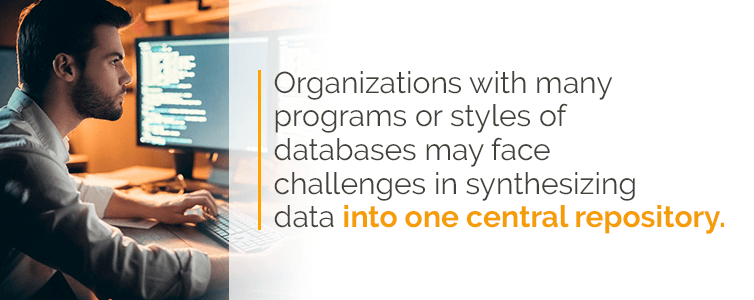
2. Informational Lag Times
In a world where real-time competitive intelligence is becoming the norm, not the exception, organizations must investigate the communication patterns and tools at their disposal to decrease informational lag times. While promptly accessing tactical data is pivotal, that data does nothing if it can’t be shared, cross-reviewed and discussed with relevant colleagues. To practice actionable intelligence, organizations must first practice actionable communications, simplifying information flows or reworking business-case alerts to escalate data-backed decision-making as it strikes.
3. Infrequent Meta-Analysis
Meta-analysis, or data about data, temperature-checks how and why your organization uses its data applications. Frequent meta-analysis can correct flawed data uses or inquiries, as well as pinpoint ways to better organize, contextualize, experiment with and validate the information held within your systems.
Performing business data meta-analyses is an often overlooked aspect of data-driven competitive intelligence but ensures the data underpinning operations is itself in peak condition.
4. Disconnect With Business Applications
New data programs or reporting activities cannot be out-of-touch with the actual users at your organization. Data warehouses or comparable systems requiring a certified data specialist to mediate information only aggravate communication and decision lag times, stifling the very progress you’re attempting to make.
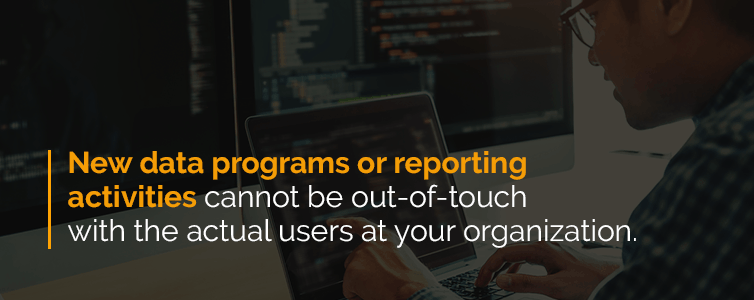
5. Conflating Reporting With Analysis
Even today, well-intentioned leaders think they’re performing market intelligence and analysis — when in reality, they’re occasionally skimming auto-generated reports.
Data reports are not synonymous with data analysis. Reports display raw information and indicate patterns and trends but don’t indicate what to do about them. Analytical decision-making comes when audiences apply critical thinking and pointed questions to the reports in their hands, through activities like:
- Formalizing hypotheses, creating test simulations and tracking the results of hypotheses, all based on presented data.
- Turning to reports when considering specific business-case questions.
- Looking beyond categorizing lines and numbers as “positive” or “negative” and instead as indicators for innovated change.
- Regularly running meta-analyses on their own data usage and practices, seeking to improve overall data culture.
Make the Most of Your Data
Set your organization on the path toward actionable data success with proven strategic planning and competitive intelligence services delivered with Proactive Worldwide.
Our consulting services have one goal — to identify clearer paths toward competitive success using substantive data and tactical research tailored for you. See how CI data can advance your business goals and turn data actionable today.













